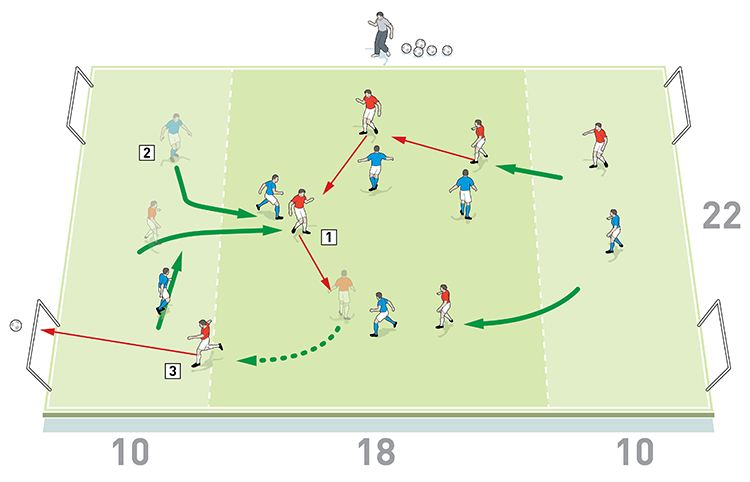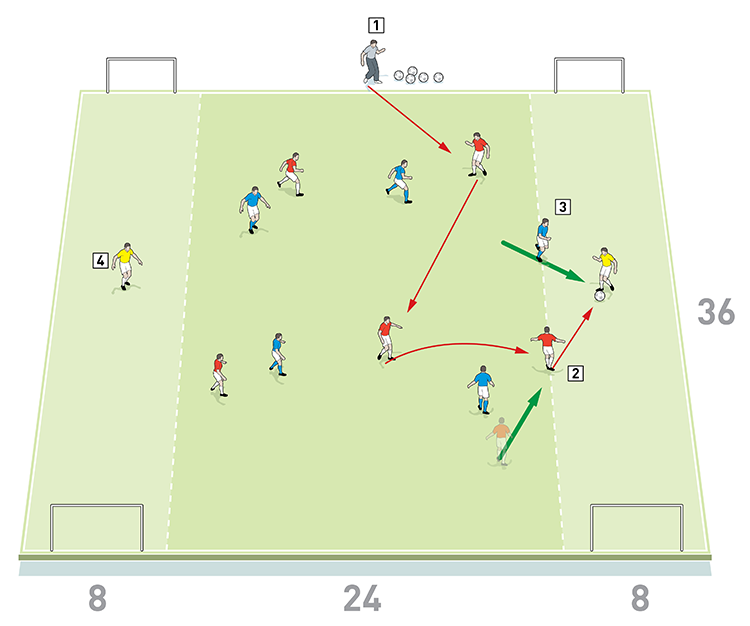You are viewing 1 of your 1 free articles
Creating attacking overloads
Create overloads in attacking situations, whether that be while playing out from the back, attacking in wide areas, or attacking in the final third.
| Area | Up to 40x36 yards |
| Equipment | Balls, bibs, cones, 4 target goals |
| No. of Players | 12 players |
| Session Time | Build or break: 10mins, Switch play: 10mins |
This training session is all about creating overloads in attacking situations, whether that be while playing out from the back, attacking in wide areas, or attacking in the final third. It challenges players to play in tight areas and encourages them to be creative and positive at all times. It also has them probing defences and keeping pressure on the opposition.
We would run this session regularly, so that players learn they should always give passing options to their team mates when in possession.
What do I get the players to do?
Build or break
We set up an area of 38x22 yards with two target goals and a 10-yard defending zone at each end. We’re using 12 players, split into two teams; each team has two defenders, three midfielders and one striker positioned in their appropriate zones.
The coach starts play by passing to one pair of defenders and they must string three passes together under pressure from the opposition striker, as shown [1a]. One midfielder can drop into the end zone to assist the defenders and to give them a 3v1 overload. This will encourage players to play out from the back and give them confidence playing in tight areas.
1a

2. The defenders must pass the ball in their zone. A midfielder can drop in to support, making it 3v1
3. After three passes they can play forward. The midfielder returns to his zone and one defender can support, making a 4v3 overload in the middle
4. The team must find a way to play into the striker in the end zone as soon as possible
5. Two midfielders can join the striker to create a 3v2 in the end zone. The idea is to score but they can also earn a goal for six passes in the zone
After three passes have been made, they can then pass forwards or drive with the ball into the midfield zone. The midfielder returns to his zone along with one defender, creating a 4v3 overload in the midfield zone. They must play into the striker in the attacking zone as soon as possible. Two midfielders can join the striker to create a 3v2 attacking overload and the idea is to score in one of the unguarded target goals. If they cannot find the net, every six passes will score them one goal. This will encourage them to keep the ball in the end zone and pile pressure on the two defenders.
The same basic rules and principles apply if the defending team win the ball back, as shown [1b]. After regaining possession, they must try to score on the counter attack, creating overloads and by building play or breaking fast.
1b

2. It’s vital that teams try to score as quickly as possible
We would play two four-minute games but times could be adjusted depending on our schedule and how close to match day we are.
How do I progress the session?
To progress the session, we would allow the striker to drop back into the midfield zone like a false 9, as shown [1c]. This creates a 5v3 midfield overload in favour of the team in possession.
1c

2. If it’s too easy for the attacking team, allow a defender to follow the striker into the midfield to create a 5v4
3. Look for midfielders to make runs into the space that the defender has vacated
To progress the session further, and to challenge the previous progression if it makes the practice too easy for the attacking team, we would encourage one of the defenders to follow the striker into the midfield zone, making it 5v4 in favour of the attackers. Now we are looking for midfielders to make runs in behind and into the space in the end zone that the defender has just vacated.
As it progresses, the session becomes more like a normal game, with players making their own decisions about when to drop based on what the opposition are doing. But they must always follow the same underlying principles: can they create an overload in every area of the pitch and can they score as quickly as possible?
What do I get the players to do next?
Switch play
We set up an area of 40x36 yards with an eight-yard channel on each side. We’re again using four target goals, one positioned at each end of the wide channels. We’re using 12 players, with two teams of five in the middle zone and two neutrals who play for the team in possession, one in each channel, as shown [2].
2

2. Teams play the ball into the wide channel where the neutral plays for the team in possession. One attacker can join him in the zone and they must try to score
3. One defender can also follow the ball into the channel to stop the attacker and the neutral scoring
4. If the attackers can’t create a chance in one channel, they should recycle the ball and try to switch it to the other channel. They earn a point if they string 10 passes together
The coach starts play by passing to one of the teams in the middle zone. The game is directional and teams must try to score at the end they are supposed to be attacking. Teams must get the ball out to a neutral player in one of the wide channels, with one attacker and one defender allowed to join the play in the channel, creating a 2v1 in the wide areas.
The aim is to score in that goal, but if the chances don’t come, encourage teams to come out of the channel and recycle the ball in order to score in the other channel.
If the team in possession can string 10 passes together, it is awarded one goal. This will encourage the defending team to come out and put pressure on the ball.
We would play two four-minute games.
What are the key things to look out for?
We would look at the quality of the pass and the type of pass being made: is it positive and what is the immediate outcome?
Also, the movement of players is crucial to the success of this session. They must be aware of the spaces left by opponents and how they can punish the opposition immediately.
Related Files
Editor's Picks
Deep runs in the final third
Using the goalkeeper in build-up play
Pressing principles
Intensive boxes drill with goals
Penetrating the final third
Creating and finishing
My philosophy
Pressing initiation
Compact team movement
Coaches' Testimonials

Alan Pardew

Arsène Wenger

Brendan Rodgers

Carlos Carvalhal

José Mourinho

Jürgen Klopp

Pep Guardiola

Roy Hodgson

Sir Alex Ferguson

Steven Gerrard
Coaches' Testimonials

Gerald Kearney, Downtown Las Vegas Soccer Club

Paul Butler, Florida, USA

Rick Shields, Springboro, USA

Tony Green, Pierrefonds Titans, Quebec, Canada
Join the world's leading coaches and managers and discover for yourself one of the best kept secrets in coaching. No other training tool on the planet is written or read by the calibre of names you’ll find in Elite Soccer.
In a recent survey 92% of subscribers said Elite Soccer makes them more confident, 89% said it makes them a more effective coach and 91% said it makes them more inspired.
Get Monthly Inspiration
All the latest techniques and approaches
Since 2010 Elite Soccer has given subscribers exclusive insight into the training ground practices of the world’s best coaches. Published in partnership with the League Managers Association we have unparalleled access to the leading lights in the English leagues, as well as a host of international managers.
Elite Soccer exclusively features sessions written by the coaches themselves. There are no observed sessions and no sessions “in the style of”, just first-hand advice delivered direct to you from the coach.









